Undressing room - Krema II gas
chamber
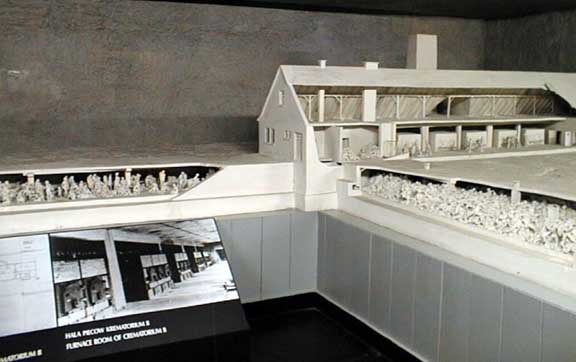 Model of Krema II gas
chamber and crematorium
Model of Krema II gas
chamber and crematorium
The photo above shows a model of the
Krema II gas chamber at Auschwitz-Birkenau, which is an exhibit
in the US Holocaust Memorial Museum in Washington, DC. On the
left is the underground room where the victims were forced to
undress. The gas chamber is shown on the right side of the photo.
A small elevator was used to lift the bodies up to the cremation
ovens, which were on the ground floor of the building. The prisoners
who worked in the crematorium lived in the attic space above
the ovens.
The photo below shows the ruins of the
undressing room on the right, only a few feet from the steps
of the Intrnational Monument at Birkenau. In the foreground is
the floor of the oven room where the bodies were burned after
the Jews were gassed. In the background is the grove of trees
that marks the western boundary of the Birkenau camp, with a
guard tower in the right hand corner of the photo.
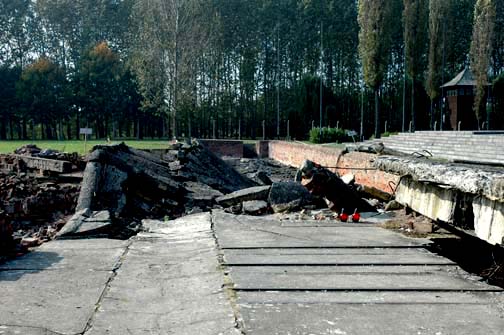
Steps down into the
undressing room in the center background
After descending into the undressing
room, the prisoners were instructed to take off all their clothes
and hang them on hooks on the wall; they were told that they
were going to take a shower. Then the naked victims, men, women
and children all together, walked to the end of the undressing
room where there was a door into a small vestibule, called the
Vorraum. A door on the south wall of the Vorraum led into the
gas chamber, which was at right angles to the undressing room.
The gas chamber was disguised as a shower room with fake shower
heads, which are now gone; the hooks in the undressing room have
also never been found. The victims soon learned, to their horror,
that they had been duped. The shower room was actually a gas
chamber where Zyklon-B gas pellets were thrown in through four
holes on the roof.
According to a book entitled, "The
Bombing of Auschwitz: Should the Allies Have Attempted It?"
by Michael J. Neufeld and Michael Berenbaum, the gas chambers
in Krema II and Krema III were 99 feet long by 23 feet wide.
The undressing rooms in both buildings were 162 feet long by
26 feet wide. The section of these T-shaped buildings, which
was above ground, was 99 feet long by 37 feet wide, and the overall
size of the long part of the buildings was 352 feet by 41 feet.
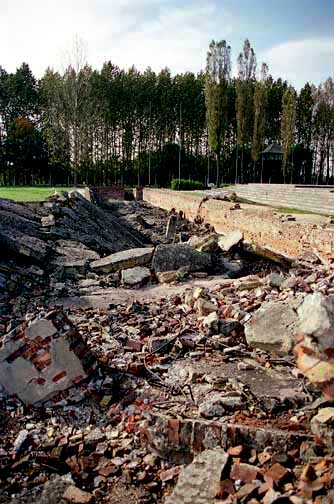 Ruins of the oven room
with undressing room in background
Ruins of the oven room
with undressing room in background
On the far right in the photo above,
you can see the steps of the International Monument which are
only three or four feet from the entrance to the undressing room
of Krema II where 500,000 Jews descended to their death. In the
foreground of the photo above is the remains of the ground-floor
furnace room.
The Krema II gas chamber and the undressing
room were both about five feet underground, but not directly
underneath the brick one-story building which housed the cremation
ovens.
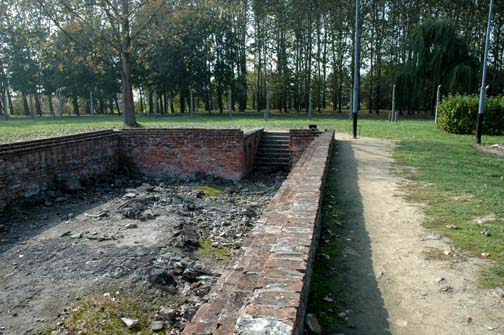 Steps down into the
undressing room for Krema II gas chamber
Steps down into the
undressing room for Krema II gas chamber
The photo above shows another view of
the steps down into the undressing room, which was a bit larger
than the gas chamber. Note that the undressing room does not
appear deep enough to be an underground room. The concrete roof
of this room was 3 feet above ground.
Note in the photo above that there is
no path leading to the steps down into the undressing room. Krema
II and Krema III were both enclosed by an interior barbed wire
fence, which you can see in the background of the photo above.
To access the undressing rooms at Krema II and Krema III, the
prisoners had to walk down the main camp road and enter the enclosure
through a gate that faced the main camp road, then walk around
the building to the west side where the steps down into the undressing
rooms were located. The location of the gates into the Krema
II and Krema III enclosures are now covered by the International
Monument.
The photo below, taken with the camera
pointing north, shows the collapsed roof of the gas chamber in
Krema II, which is at right angles to the undressing room; the
International monument is in the backrground.
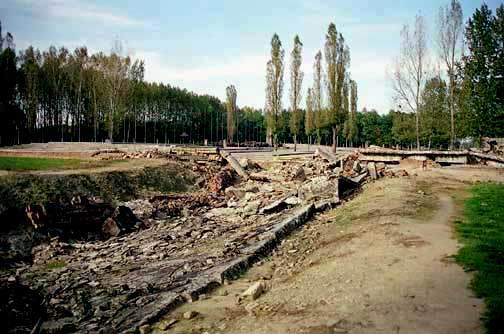 Ruins of the gas chamber
in Krema II
Ruins of the gas chamber
in Krema II
The gassing of the Jews at Birkenau stopped
on the first of November 1944; the roof of the Krema II brick
building was taken off and the cremation ovens were lifted out
with cranes. The fake shower fixtures on the ceiling of the gas
chamber were removed and all traces of them are now gone. Then
the wire-mesh columns inside Krema II, into which the poison
gas pellets had been poured, were removed.
During the David Irving libel case, Robert
Jan van Pelt testified as an expert witness that the holes in
the roof were closed up and cemented over so skillfully that
no trace of them can be seen today. Only then were the gas chamber
buildings blown up to destroy any remaining evidence.
BBC video of Auschwitz-Birkenau
ruins
This page was last updated on February
25, 2010
|